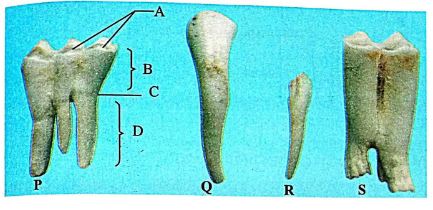BIOLOGY
Paper 3
Instructions
- Answer all the questions in the spaces provided.

Questions
- You are provided with photographs of seedlings labeled K and L. examine them
- Given that the two plants belong to the same class, name the class and give a reason based the observable features features on any of the two seedlings. (2mks)
- Class
- Reason:
- State giving a reason the type of germination that occurs in each of the two seedlings.(4mks)
- K
Reason - L
Reason
- K
- Name the parts labeled H and G on the seedlings. (2mks)
- Name the type of roots system that will develop in the two seedlings. (1mk)
- The roots of both seedlings may develop swelling later in life.
- Name the organisms that are to be found in the swellings. (1mk)
- What is the role of the organisms that you have mentioned in (i)above. (1mk)
- Name and explain the relationship that exists between the organisms you have named in (ii) above and the plants. (3mks)
- Given that the two plants belong to the same class, name the class and give a reason based the observable features features on any of the two seedlings. (2mks)
- You are provided with photographs of specimens labeled P,Q,R and S which were obtained from the same animal. Examine them
- With a reason identify P and Q. (4mks)
P
Reason
Q
Reason - Using observable features only state.
- One similarity between specimen Q and R. (1mk)
- One difference between specimen R and S. (1mk)
- Explain how specimen S is adapted for its functions. (2mks)
- In specimen P name the four parts labeled A,B,C & D. (4mks)
- With a reason identify P and Q. (4mks)
- You are provided with a mature orange fruit labeled specimen H,0.01% D.C.P,IP solution, Benedicts solution, iodine, dropper, means of heating,3 testtubes,1 test tube holder, test tube rack, filter paper, filter funnel,1 100ml beaker.
- Cut specimen H transversely into 2 halves. Squeeze the juice from the two halves into a small beaker. filter the juice and discard the residue. Using part of the juice and the reagents provided only, test for the food substances in the juice and record observations and conclusions in the table below.
Food Procedure Observations Conclusion Starch Reducing sugar Vitamin C - Using the other half, observe it carefully draw and label its parts. (4mks)
- Name deficiency disease in human that may result from deficiency of Vitamin C. (1mk)
- Cut specimen H transversely into 2 halves. Squeeze the juice from the two halves into a small beaker. filter the juice and discard the residue. Using part of the juice and the reagents provided only, test for the food substances in the juice and record observations and conclusions in the table below.

Confidential
Reagents
- 0.01% D.C.P.P
- Benedict’s solution on the access
- Iodine solution
Apparatus
Each student should be provided with the following:
Means of heating on access point
- 3 test tubes
- 1 test tube holder
- 10ml measuring cylinder
- 1 test tube rack
- 1 filter paper
- 100ml beaker
- Droppers on the access.
- 1 scapel
Specimens
- 1 mature orange fruit labeled H.
Photographs
- Coloured photographs of specimens
- K
- L
- P
- Q
- R
- S

Marking Scheme
-
- Class - Dicotyledonae
- Reason:
- Prescence of two cotyledons in specimen L.
- Network venation on the plumule leaves in specimen L.
-
-
- K -Hypogeal
- Reason - Cotyledons remain in the ground
-
- L - Hypogeal
- Reason - Cotyledons are brought above the ground.
-
-
- H - Epicotyl
- G - Hypocotyl
- Both will develop tap root system.
-
- Rhizobium bacteria.
- Nitrogen fixation.
- Symbiosis- the bacteria converts atmosphere nitrogen into ammonia some of which is taken up by plants in the manufacture of amino acids. The bacteria in turn obtains shelter and carbohydrates from the plant.
-
-
-
- P - Molar tooth
- Reason
- Biting surface is wide and has cusps /ridges.
- Prescence of three roots.
-
- Q - Incisor
- Reason - Biting surface is chisel shaped with sharp pointed tips.
-
-
- Both have one root.
-
- R has a pointed biting surface while s has a broad biting surface with cusps/ridges.
- R has one root while. S has two roots.
- It has cusps /ridges on its biting surface that enable crushing and grinding of food.
- A-Cusps/ridges
B-Crown
C-Neck
D-Root
-
-
-
Food Procedure Observations Conclusion Starch - Put 2ml of juice from specimen H in a clean test tube.
- Add 2 drops of iodine solution and shake.
The yellow colour of iodine solution persists. Starch absent. Reducing sugar Put 2ml of juice from specimen into a clean test tube. Add equal amounts of benedict’s solution and heat to boil and shake. The colour changes from blue ,green, yellow to orange. Reducing sugars present. Vitamin C - Put 2ml of D.C.P.I.P Solution in a clean test tube.
- Add juice from specimen H drop wise while shaking.
D.C.P.I.P is decolourized. Vitamin C present. - Using the other half, observe it carefully draw and label its parts. (4mks)
- Drawing (1mk)
- Labeling at least 2 parts (2mks)
- Magnification (1mk)
- Vitamin C
-
Download Biology Paper 3 Questions and Answers with Confidentials - Form 4 Opener Term 1 Exams 2022.
Tap Here to Download for 50/-
Get on WhatsApp for 50/-
Why download?
- ✔ To read offline at any time.
- ✔ To Print at your convenience
- ✔ Share Easily with Friends / Students



